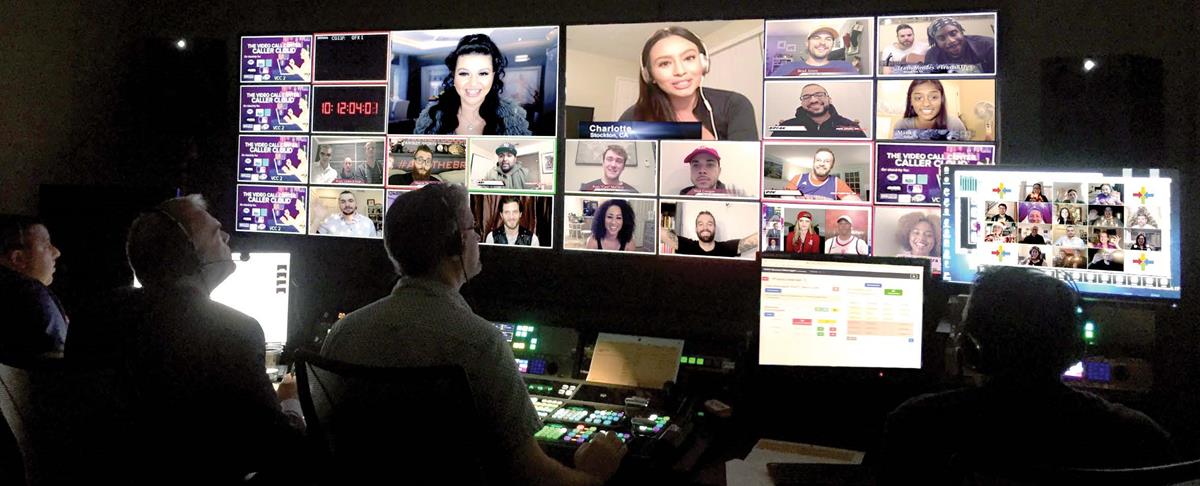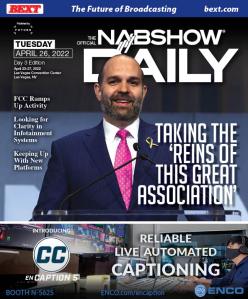
By Peter Suciu, TV TECH
Flexibility, cost-efficiency and work-life balance are among benefits.
It was fortunate for broadcasters and video production teams that migration to the cloud was well underway when COVID-19 began to affect the world in 2020. Stations and film crews were able to pivot quickly, creating remote production solutions to meet the demand by viewers for more content who were stuck at home. Is this the new norm for production workflows?
“During the pandemic [broadcasters] jumped into whatever lifeboat they could find,” said Larry Thaler, CEO of The Video Call Center. “Production was done with Skype, Microsoft Teams and even Zoom — whatever we could use to get things on the air, and business cobbled it all together.”
The Video Call Center is showcasing its Airfirst platform, an end-to-end enterprise-level system designed for production teams to connect with guests anywhere in the world for TV, streaming, live or corporate events.
“We have a customer who is using it to connect with refugees in Ukraine,” said Thaler. “We’ve seen the tools that can consolidate the workflow; and the controls that can bring it together will be the next step in remote production.”
Thaler is a speaker for today’s CM|IP and Future of Delivery’s session “The TV Industry’s New Normal — Lessons Learnt From The Pandemic,” taking place in the CM|IP Theater, 11:20 a.m.-noon, and is open to all registered attendees.
REMOTE ACCELERATION
In many ways the pandemic simply accelerated the move towards remote production, and it is unlikely that everyone will be returning to the office or production facilities.
“The assumption was that this would be for a short period of time. It has been two long years now, and during the pandemic, there was a realization that remote production could save money,” said Thaler. “We’re seeing the savings in money from not needing to bring a guest into a remote studio — and the guests can do this more easily from their homes.”
“During the pandemic, people had a chance — involuntary as it was — to try out workflows that they had not tried previously,” said Dan Pisarski, vice president of engineering at LiveU. “Cloud technology has changed all this, and it has had a pretty big impact in the ability to work remotely.”

Pisarski will present today’s session “Adopting New Cloud Workflows and Making Live Happen in This New Normal,” from 9:15-9:35 a.m. The session is part of the Broadcast Engineering & IT Conference and an NAB Show Conference Pass is required.
“The move to virtual production really picked up during the pandemic,” said Kari Grubin, who heads the on-set virtual production initiative for SMPTE’s RIS (Rapid Industry Solutions) program. “What was found is that you don’t have to have as many people travel to these events. You can have a crew build a set and not travel.”
Yet, the pandemic alone can’t be credited with the move to remote production.
“It’s obvious over the last couple of years that everyone was forced to be creative and push remote production forward. I’d dare say that more advances were made in the last couple of years than in the previous decade,” said Mike Flathers, chief solutions officer at Signiant.
NEW NORMAL COULD BE A HYBRID
It has been suggested that in 2022 and beyond we’ll see a hybrid approach that combines some of the pre-pandemic production methods mixed with what was learned during the pandemic to create greater efficiency.
“There may be companies that depend on a large workforce in-house, and some of those people will need to come back,” said Grubin, “but I expect we’ll see a hybrid approach as more people continue to work remotely.”
“What we have to remember is that we’ve been doing a lot of this since the silent age with rolling backgrounds on sound stages,” Grubin said. “However, the technology has advanced considerably and now it is to the benefit of the production teams and the audience.”
Viewers also adjusted to the new normal.
“Now that we are returning to the studio, we’re still seeing that instead of connecting with guests from a remote studio, viewers are accepting that we’ll see them from their homes, even as anchors are back in the studio,” added Pisarski. “We found that talent can do some things remotely without everyone having to be in the same room.”
BRINGING IT TOGETHER
AVT Audio Video Technologies GmbH is among the exhibitors offering solutions to help production teams benefit from this new normal. The company facilitates remote production scenarios and continues to develop features for this need. That includes its Telephone Hybrid systems that offer remote production capabilities.
“Our optional features Pretalk Streaming and the new MAGIC Collaboration Server offer solutions that eliminate workflow differences between working remotely vs. in a production studio,” explained Lukas Mahler, junior marketing and sales manager at AVT. “Both can be found in the options of our flagship system MAGIC THipPro. This feature is used by German public broadcasters in large scale, as many screeners are still working from home.”
An advantage that it offers is that, without any additional equipment, full productivity can be achieved remotely without compromises.
“Additionally, we now offer the MAGIC Collaboration Server, which allows reporters, remote staff or external callers to connect to the telephone hybrid via MS Teams,” added Mahler. “This way remote reporting or calling in with high quality is easy, and independent from the telephone infrastructure.”
CHANGES HERE TO STAY
Remote production may have been cobbled together, but in 2022 and beyond vendors will play a role in ensuring they are on the same path.
“This year and next will bring more ‘integrated’ out-of-the-box, tried, true and tested solutions in the form of mix-and-match building blocks allowing freedom of choice around best-of-breed point technologies,” added Signiant’s Flathers. “Kind of thinking of the ‘powered by’ type of marketing with true collaboration between vendors rather than pushing a one size fits all, single vendor model.”
Perhaps the biggest lesson of the past two years is that there was an acceleration to the adoption of cloud-based technologies and there is no going back.
“We can get by as long as we have the right tools in place,” explained Gabriel Baños, CEO and founder of cloud-based graphics provider Flowics. “Many of the changes we’ve experienced are here to stay, even post pandemic. As an industry, we found that new production workflows could be more cost-efficient, more flexible and offer a better work-life balance for production crews.”
Baños will participate in today’s CM|IP and Future of Delivery’s session “Turning to the Cloud to Reduce TV Service CAPEX And OPEX,” 2–2:40 p.m., in the CMIP Debate Theater.
“I believe we’ll see more producers building anticipation and awareness of their productions by using online platforms to drive more and more people to their digital properties and to generate larger viewer interaction,” he said.



Discussion
Responses (2)